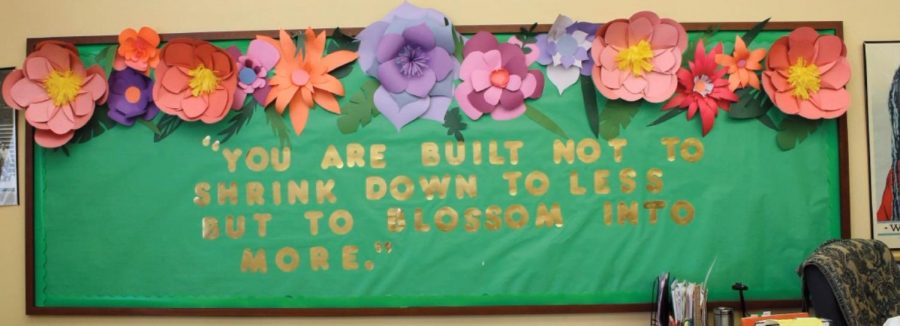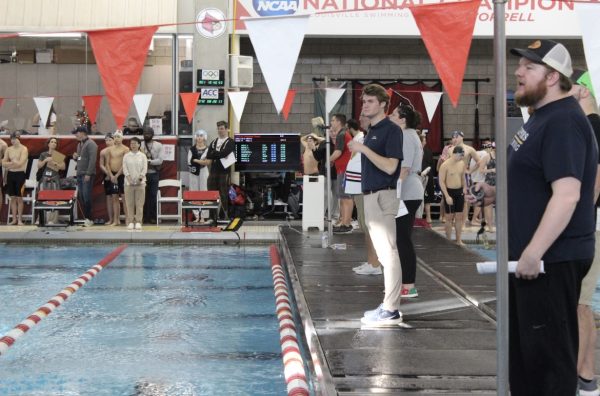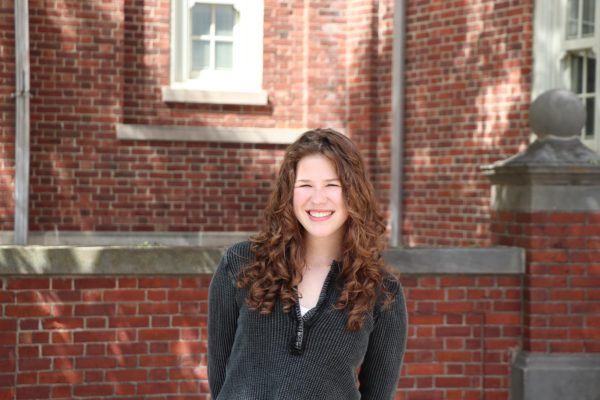Wellness Wednesday
Bringing student well-being into the classroom
This year, English teacher Margo Fisher-Bellman has incorporated discussion about mental health with Wellness Wednesdays. Even before she began Wellness Wednesday, Fisher-Bellman tried to bring positivity into her room visually. “I wanted my room to even have those words visible so that somebody could read them every day, even though that’s incredibly superficial,” she said.
English teacher Margo Fisher-Bellman has brought student wellness into her classes by setting aside class time every Wednesday to discuss, practice and learn about mental health and wellness.
Fisher- Bellman first had the idea for Wellness Wednesday in July 2018.
“Ever since I had been at Walnut, I had noticed the pretty significant stress and anxiety of students… I wanted something to be visible in my classroom,” Fisher-Bellman said. “I was actually riding on the Megabus back from visiting a friend in Chicago, listening to The Hate U Give audiobook, and I thought, you know what, I need to do something,”
By the time she arrived home, she had started planning and ordering materials.
Throughout the year, Wellness Wednesday has included guided meditations, breathing exercises and other anxiety management techniques. Students tried a month of habit and sleep tracking inspired by bullet journaling. Fisher-Bellman has also implemented a table top game developed by former WHHS students, which prompts groups of students to talk about mental health and their own experiences.
“I think what’s really awesome, because I do it with tenth and eighth grade, is seeing even younger students take the risk to meditate in a classroom,” she said.
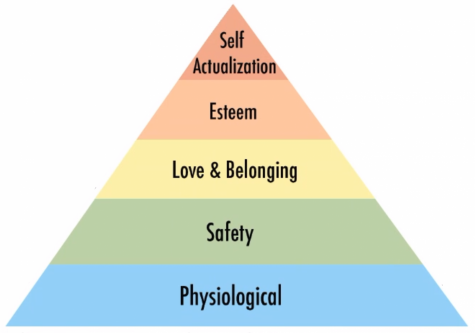
Maslow’s Hierarchy of Needs is a motivational theory. Needs lower in the hierarchy must be met before those at the top.
Fisher-Bellman has also used Wellness Wednesday as an opportunity to educate students about the science behind mental health.
“With students at Walnut being so academically oriented, and parents wanting rigor, I was concerned that there would be backlash among students or parents that they wouldn’t want it,” she said, “So I created a pretty significant rationale to begin with. I tried to do a lot of science based stuff to begin with, just because I thought that that might appeal more, and so we can see why we’re doing what we’re doing. But I haven’t had any pushback.”
One of the first topics that the class discussed was Maslow’s Hierarchy of Needs, a psychological theory that arranges a pyramid of basic human needs. Maslow placed physiological needs at the bottom, followed by safety, love and belonging, self-esteem and self-actualization at the top. Fisher-Bellman connected the theory to students, explaining that students can only focus on self-actualization, growth and fulfilling their potential once the other needs have been met.
“I think that when you take something like meditation and illustrate the hard science behind it, like why this might be helpful, I think that really speaks to Walnut kids a lot, because they want to understand,” she said.
In a survey conducted after first semester, 100 percent of her students said that they wanted to continue Wellness Wednesday.
Although some students find certain activities less helpful or comfortable, the majority reported that they take Wellness Wednesday seriously and consider it to be worthwhile. Fisher-Bellman attributes this not only to students understanding the importance of wellness, but also simply appreciating a break in their day and homework schedule.
Along with in-class activities, Fisher-Bellman has committed to not assigning homework on Wednesdays. Although the adjustment was not easy, the practice has benefited students’ wellness and success.
According to Fisher-Bellman, when students fell behind in the past, they struggled to catch up. The day off has resulted in more spikes in quiz scores, indicating that students are recovering from setbacks and staying on top of work.
“One thing it allows is a bit more discussion about what we have read in the past and a little bit more time for group work,” Fisher-Bellman said. “It feels like that slower pace allows for more depth, which I like, but it did take getting used to.”
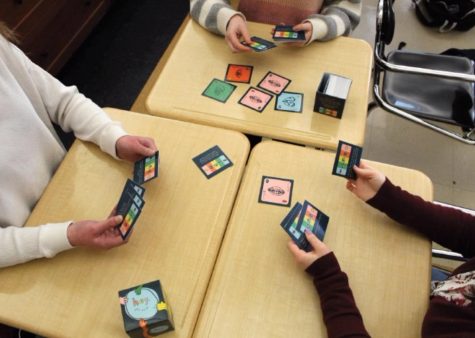
One Wellness Wednesday activity is playing Hey, Let’s Talk, a card game made to help start productive conversations about mental health. The game was designed by ArtWorks and Interact for Health.
Inspired by Fisher-Bellman and their own experiences with wellness at WHHS, a few other teachers have adopted similar practices.
Although the practice of Wellness Wednesday may not be viable on a school-wide level, Fisher-Bellman believes that some elements, like homework breaks, could work on a greater scale. Fisher-Bellman also supports the work of 1N5, a local organization that aims to improve the culture of mental health in schools.
About a week after she stepped off the Megabus and began to plan Wellness Wednesday, Fisher-Bellman was having breakfast in a cafe where she overheard a conversation about student wellness. That is how she met Nancy Eigel-Miller, the executive director of 1N5. The two stayed in contact, and 1N5 has extended its efforts to WHHS this year. Fisher-Bellman attributes the success of this partnership to the involvement of Assistant Principal Ashley Thomas-Morgan.
As WHHS continues to pursue improved student well-being, Wellness Wednesday is one example of how progress can start in the classroom. Though it has become a weekly ritual, it began with one person’s desire to make an impact.
“I know what it feels like to be overwhelmed and exhausted and sad and anxious. And I think that we don’t talk about it enough, and when we isolate it, we feel worse about it,” Fisher-Bellman said. “It just all felt like it was the right time.”
Your donation will support the student journalists of Walnut Hills High School. Your contribution will allow us to purchase equipment, cover our annual website hosting, printing costs and offset competition and conferences fees for students.



